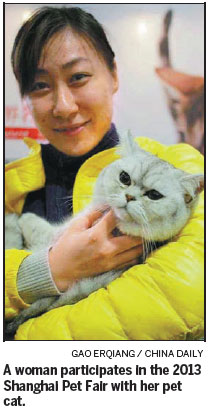Cats were friends of Chinese since ancient times
Updated: 2014-01-17 07:17
By Eliana Kirshenblat (China Daily)
|
|||||||||||
Although cats may be one of the most popular pets today (there are an estimated 600 million worldwide), precious little is known about how and when humans and cats struck up their close relationship.
The earliest evidence for close human-cat interaction dates back to prehistoric Cyprus, where the remains of a wildcat and a human-dated 9,500 years old-were found buried together.
The earliest evidence of domesticated felines comes courtesy of Egyptian art dating back 4,000 years.
Between those years there has been a huge knowledge gap-until now.
A new study in the Proceedings of the National Academy of Sciences has confirmed the first direct evidence of a human-domestic cat relationship among Chinese farmers 5,300 years ago.
Researchers studied the bones of cats, dogs, deer and other animals unearthed in an excavation near Quanhucan, a village in Central China, led by the Institute of Archaeological Research of Shaanxi in 1997. Using radiocarbon dating and isotopic analysis of trace amounts of carbon and nitrogen, scientists were able to show that the cats were living on a mostly millet-based diet, just like the domesticated dogs and pigs from the site.

"The most reasonable explanation for a high consumption of millet-based food is that the cats had formed a stable and mutual relationship with humans and could easily prey on rodents around human villages, find leftover food or even have been fed by people intentionally," writes study co-author Hu Yaowu of the Chinese Academy of Sciences in Beijing.
The research was done as a joint effort between the academy and Washington University in St. Louis. Hu, whose research focuses on the relationship between humans and domesticated animals, joined the team to look for evidence of the contribution of millet agriculture to the domestication of animals.
"It is very interesting for us to find the consumption of millet-based foods by the cats" since this kind of evidence had long been missing, Hu explains.
Since cats usually eat meat, such a diet would be unexpected, unless the cats were being fed by people, the study argues.
The researchers also found that one of the cats survived to reach old age, implying that it had a safe place to live and enough to eat. Taken with the other evidence, that shows a well cared for animal, the study suggests.
Why the farmers wanted to keep cats nearby-or make them "pets"-could be answered by other evidence. Chinese archaeologists found ceramic storage containers in the village that were specifically designed to keep out rodents-a vermin that cats, being notorious rodent hunters, could certainly have helped with.
The simplified theory is that rats were attracted to the food of farmers, and so were harmful to farmers. Cats were attracted to the rats, and so farmers formed a mutually beneficial relationship with cats, taking care of them in return for pest control.
Despite all the evidence, one big mystery remains-where did the cats in the study come from? That, the study says, will take further research to figure out.
(China Daily 01/17/2014 page22)
Today's Top News
China draws a step closer to balanced flows
Xinjiang doubles terror fight budget
China bulks up maritime fleet
Lunar probe sets out on new missions
Russia battle militants before Olympics
Hollande responds to affairs reports
China and Italy agree to boost cooperation
Party school official suspended after scandal
Hot Topics
Lunar probe , China growth forecasts, Emission rules get tougher, China seen through 'colored lens', International board,
Editor's Picks

|

|

|

|

|

|





